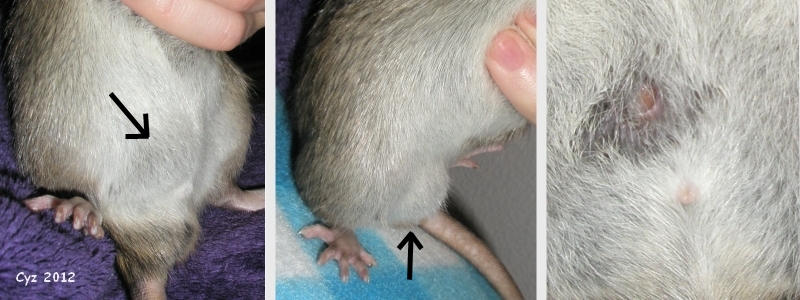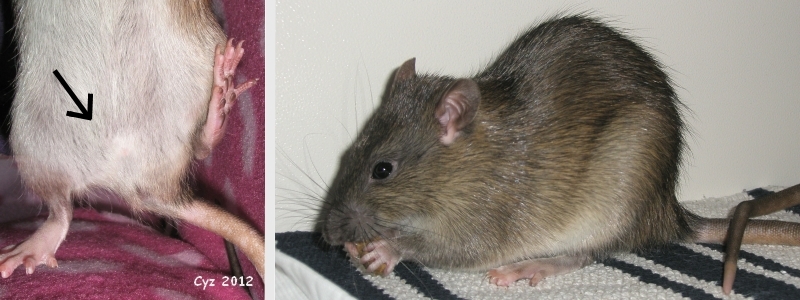Figure 5e: Post surgical abscess related to neutering in 2-month-old male rat (Gambit).
Case history and photos
History
Gambit (neutered agouti self male rat) and his siblings are the result of an unplanned mating between a “released” 9-12 month old domestic female Rattus norvegicus and an unknown wild male Rattus norvegicus. Gambit was born in a rat rescue on 27 October 2010.
A scrotal neuter was performed on Gambit on 20 December, when he was almost two months old. The reason the male siblings were neutered at such an early age, was to reduce the chance of hormonally-induced territorial aggression later in life and to increase their chance of being placed. The choice was influenced by their being semi-wild rats, and by an accidental tail injury in one of the males, which required surgery anyway: he was adopted as soon as it became apparent that he would be neutered at the same time.
Gambit was adopted from the rat rescue on 8 January 2011, along with another neutered semi-wild male. The small group of resident rats contained intact females, so the introduction was postponed until almost a month post-neuter.
Clinical Signs
On day 26 post-neuter an approximately 1.5cm3 hard lump was noticed on Gambit’s belly, just above and slightly to the right of his penis. Over the course of the following days, the lump enlarged by about 50%. Gambit was uncooperative (fidgety) during inspections, but did not appear to be in discomfort.
Diagnosis
After the discovery of the lump, the rat rescue was consulted and Gambit was taken to a vet. Both parties suspected the lump to be an abscess related to the neuter, possibly involving the vas deferens (the duct that carries sperm from the testes to the penis) and/or caused by sperm leakage during the surgery.
Treatment
The vet’s suggestion was to wait a few days and – if the abscess had not opened up by then – to surgically remove it, to rule out any chance of it opening up internally.
However, after consulting the rat rescue and other rat keepers who had experienced abscesses in similar locations in their own male rats, we decided to wait a bit longer. In addition, we decided to commence with the introduction despite Gambit’s enlarging belly lump.
Follow-up
On day 35 post-neuter, exactly one week after the vet trip, a small scab was noticed on the lump. Gambit was given a single oral dose of Carprofen (prescription veterinary painkiller). No antibiotics were given. Note that their cage contains only fabric and paper as bedding material; the litter boxes contain wood pellets.
The next afternoon the lump had opened up and Gambit was observed cleaning it. On day 37 the hole into the lump was somewhat larger; the tissue inside seemed a healthy dark pink. By the evening the hole was closed. A tiny hard lump could still be felt underneath the skin, but a few days later it, too, was gone.
Outcome
Gambit healed well and he did not encounter any problems during the introduction; he gets along very well with the other rats.
Comment
There were three semi-wild litters in total. All of the 11 male pups were neutered by the same vet, as soon as they were large enough (bodyweight over 150 grams). Three of them developed abscesses: Gambit, his brothers Boris, and his half-brother Twix.
Given that Boris and Twix’s abscesses did not develop until 13 weeks respectively 6 months post-op, it is possible that they were unrelated to their castration. Twix cleaned out his own abscess; it healed well. Boris’s abscess was cleaned out by a vet and subsequently by his caretaker; it also healed well. Boris did, however, develop another abscess in the opposite location at 1 year of age.
Photos
 First photo on day 26 post-neuter shows an approximately 1.5cm3 hard lump on Gambit’s belly, In the second photo on day 35 a small scab formed over the lump. In the last photo on day 37 shows the abscess is open allowing for cleaning and healing. |
 The photos in this row show Gambit and the area where the abscess had formed completely healed. |
Case history and photos courtesy of Cyzahhe


